View in other NatureServe Network Field Guides
NatureServe
Montana
Utah
Wyoming
Idaho
Wisconsin
British Columbia
South Carolina
Yukon
California
New York
Crested Shieldfern - Dryopteris cristata
State Rank Reason (see State Rank above)
Rare to uncommon in Montana where it is known from scattered occurrences across the western portion of the state. Most documented occurrences are on National Forest lands, though State Trust Lands and private lands also host significant populations.
General Description
Crested Shieldfern is an herbaceous perennial with clustered fronds arising from a short rhizome. The stalked fronds have narrowly elliptic blades pinnately divided into numerous pairs of pinnately lobed leaflets, or pinnae. The fertile fronds, 3-6 dm long, are erect and deciduous, while the sterile ones are evergreen, smaller, and more lax. Clusters of spores, or sori are borne along either side of the pinnae midveins on the underside of fertile fronds. Sori are covered by a whitish, broadly horseshoe-shaped membrane, or indusium.
Phenology
Mature fronds in July-August, spores in early July.
Diagnostic Characteristics
The broadly horseshoe-shaped indusium identifies its members as
Dryopteris.
The length ratio of downward- to opposing upward-pointing pinnules on the lowest pinnae separates Spinulose, Spreading, and Male ferns (Giblin et al.[eds] 2018; Lesica et al. 2012):
Crested Shieldfern -
Dryopteris cristata, native, SOC:
* Leaves are 1-pinnate and of two types: erect fertile fronds are taller than the sterile arching, evergreen fronds.
* Petiole is less than half as long as the blade.
* Leaves are narrowly lance-shaped in outline.
* Pinnae are deeply pinnately lobed.
Spinulose Shieldfern -
Dryopteris carthusiana, native:
* Leaves 2- or 3-pinnate at base and deciduous.
* Petiole is often shorter than the blade.
* Leaves are broadly ovate to triangular in outline.
* Leaf bladed about one-half to two-thirds as wide as long (except in very robust plants).
* The first downward-pointing pinnule on the lowest pinnae is less than twice as long and wide as the opposing upward-pointing pinnule.
* Teeth on pinna margins with a prominent spine tip about 0.05 mm long.
* Leaves deciduous.
Spreading Woodfern -
Dryopteris expansa, native:
* Leaves 2- or 3-pinnate at base and can be more evergreen.
* Petiole is often about half as long as the blade.
* Leaves are broadly ovate to triangular in outline.
* Leaf blade is about one-half to two-thirds as wide as long (except in very robust plants).
* The first downward-pointing pinnule on the lowest pinnae is at least twice as long and wide as the opposing upward-pointing pinnule.
* Teeth on pinna margins toothed with a spine tip less than 0.03 mm.
Male Fern -
Dryopteris filix-mas, native:
* Leaves are 1- to 2- pinnate at the base and deciduous.
* Petiole is about one-third or less the length of the blade.
* Leaves are narrowly elliptic or lance-shaped in outline.
* Downward- and upward- pointing pinnules are about equal in length and width.
Species Range
Montana Range
Range Descriptions
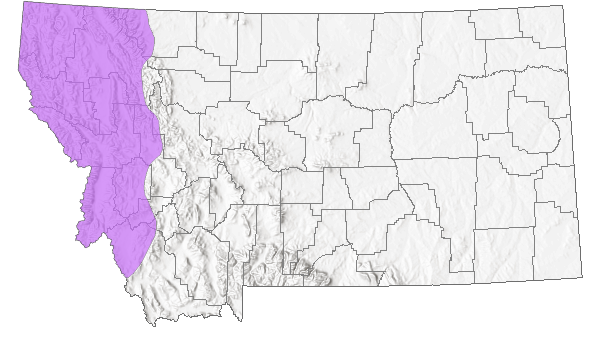
 Native
Native
Range Comments
In MT in Flathead, Lake, Missoula, Ravalli and Beaverhead counties; circumboreal south to ID, IL, and GA (Lesica et al. 2012. Manual of Montana Vascular Plants. BRIT Press. Fort Worth, TX).
Observations in Montana Natural Heritage Program Database
Number of Observations: 78
(Click on the following maps and charts to see full sized version)
Map Help and Descriptions
Relative Density
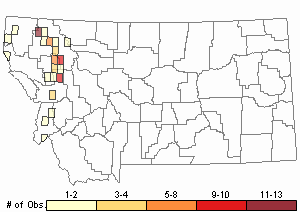
Recency
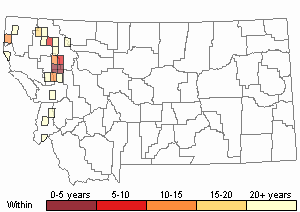

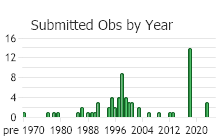
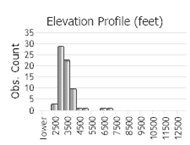 (Observations spanning multiple months or years are excluded from time charts)
(Observations spanning multiple months or years are excluded from time charts)
Habitat
Moist to wet, often organic soils at the forest margins of fens and swamps in the montane zone.
National Vegetation Classification System Groups Associated with this Species
Forest and Woodland
Montane - Subalpine Forest and Woodland
Wetland and Riparian
Peatland
Riparian and Wetland Forest
Riparian Shrubland
Wet Meadow and Marsh
Stewardship Responsibility
Threats or Limiting Factors
STATE THREAT SCORE REASON
Reported threats to Montana's populations of Crested Shieldfern include populations where Canada Thistle (Cirsium arvense) and Reed Canarygrass (Phalaris arundinacea) are established and have potential to completely occupy its habitat. Trampling due to off-highway vehicle (OHV) activity contributes additional impacts at one site despite restrictions on OHV travel at this location. Water management actions are a reported threat to a small population found at a reservoir, where water diversion or inundation of habitat is a credible risk (MTNHP Threat Assessment 2021).
References
- Literature Cited AboveLegend:
 View Online Publication
View Online Publication Hitchcock, C.L. and A. Cronquist. 2018. Flora of the Pacific Northwest: An Illustrated Manual. Second Edition. Giblin, D.E., B.S. Legler, P.F. Zika, and R.G. Olmstead (eds). Seattle, WA: University of Washington Press in Association with Burke Museum of Natural History and Culture. 882 p.
Hitchcock, C.L. and A. Cronquist. 2018. Flora of the Pacific Northwest: An Illustrated Manual. Second Edition. Giblin, D.E., B.S. Legler, P.F. Zika, and R.G. Olmstead (eds). Seattle, WA: University of Washington Press in Association with Burke Museum of Natural History and Culture. 882 p. Lesica, P., M.T. Lavin, and P.F. Stickney. 2012. Manual of Montana Vascular Plants. Fort Worth, TX: BRIT Press. viii + 771 p.
Lesica, P., M.T. Lavin, and P.F. Stickney. 2012. Manual of Montana Vascular Plants. Fort Worth, TX: BRIT Press. viii + 771 p. MTNHP Threat Assessment. 2021. State Threat Score Assignment and Assessment of Reported Threats from 2006 to 2021 for State-listed Vascular Plants. Botany Program, Montana Natural Heritage Program, Helena, Montana.
MTNHP Threat Assessment. 2021. State Threat Score Assignment and Assessment of Reported Threats from 2006 to 2021 for State-listed Vascular Plants. Botany Program, Montana Natural Heritage Program, Helena, Montana.
- Additional ReferencesLegend:
 View Online Publication
View Online Publication
Do you know of a citation we're missing? Britton, D.M. 1972. The spores of Dryopteris clintoniana and its relatives. Canadian Journal of Botany 50:2027-2029.
Britton, D.M. 1972. The spores of Dryopteris clintoniana and its relatives. Canadian Journal of Botany 50:2027-2029. Bursik, R. J., and R. K. Moseley. 1992. Forty-year changes in Hager Lake Fen, Bonner County, Idaho. Cooperative Challenge Cost-share Project, Idaho Panhandle National Forests and Idaho Conservation Data Center, Idaho Department of Fish and Game, Boise. 31 pp.
Bursik, R. J., and R. K. Moseley. 1992. Forty-year changes in Hager Lake Fen, Bonner County, Idaho. Cooperative Challenge Cost-share Project, Idaho Panhandle National Forests and Idaho Conservation Data Center, Idaho Department of Fish and Game, Boise. 31 pp. Caicco, S. L. 1987. Field investigations of selected sensitive plant species on the Idaho Panhandle National Forest. Idaho Natural Heritage Program, Idaho Department of Fish and Game, Boise, Idaho. 44 pp.
Caicco, S. L. 1987. Field investigations of selected sensitive plant species on the Idaho Panhandle National Forest. Idaho Natural Heritage Program, Idaho Department of Fish and Game, Boise, Idaho. 44 pp. Carlson, T.M. and W.H. Wagner 1982. The North American distribution of the genus Dryopteris. Contributions from the University of Michigan Herbarium 15:141-162.
Carlson, T.M. and W.H. Wagner 1982. The North American distribution of the genus Dryopteris. Contributions from the University of Michigan Herbarium 15:141-162. Cody, W.J., and D.M. Britton. 1985. Male fern, Dryopteris filix-mas, a phytogeographically important discovery in northern Saskatchewan. Canadian Field-Naturalist 99(1):101.
Cody, W.J., and D.M. Britton. 1985. Male fern, Dryopteris filix-mas, a phytogeographically important discovery in northern Saskatchewan. Canadian Field-Naturalist 99(1):101. Flora of North America Editorial Committee. 1993. Flora of North America north of Mexico. Vol. 2. Pteridophytes and gymnosperms. Oxford Univ. Press, New York. xvi + 475 pp.
Flora of North America Editorial Committee. 1993. Flora of North America north of Mexico. Vol. 2. Pteridophytes and gymnosperms. Oxford Univ. Press, New York. xvi + 475 pp. Greuter, W., B. Zimmer, and H.-D. Bdhnke (eds.). 1987. Abstracts from the XIV International Botanical Congress. 24 July-01 Aug. Berlin, Germany. p. 272.
Greuter, W., B. Zimmer, and H.-D. Bdhnke (eds.). 1987. Abstracts from the XIV International Botanical Congress. 24 July-01 Aug. Berlin, Germany. p. 272. Lellinger, D.B. 1985. A Field Manual of the Ferns and Fern-Allies of the United States and Canada. Smithsonian Inst. Press. Washington, D.C. B85LEL01PAUS
Lellinger, D.B. 1985. A Field Manual of the Ferns and Fern-Allies of the United States and Canada. Smithsonian Inst. Press. Washington, D.C. B85LEL01PAUS Lesica, P., M.T. Lavin, and P.F. Stickney. 2022. Manual of Montana Vascular Plants, Second Edition. Fort Worth, TX: BRIT Press. viii + 779 p.
Lesica, P., M.T. Lavin, and P.F. Stickney. 2022. Manual of Montana Vascular Plants, Second Edition. Fort Worth, TX: BRIT Press. viii + 779 p.
- Web Search Engines for Articles on "Crested Shieldfern"





